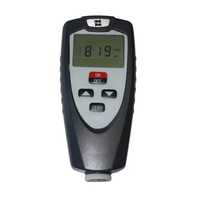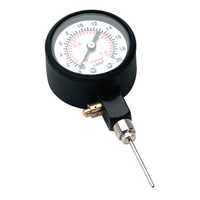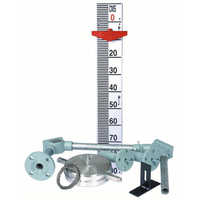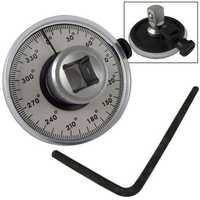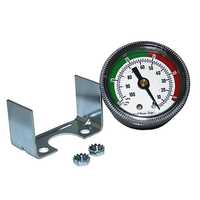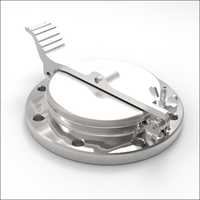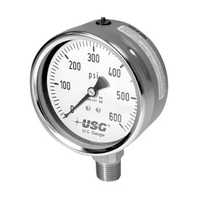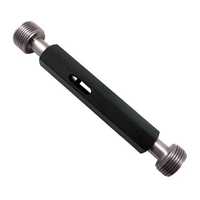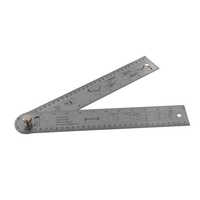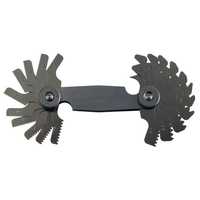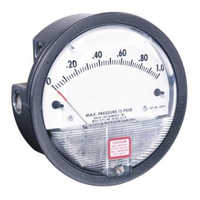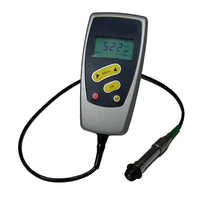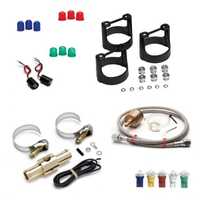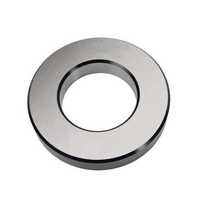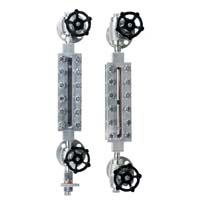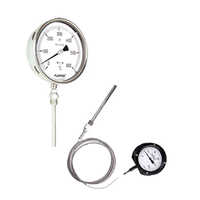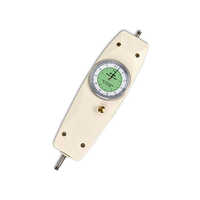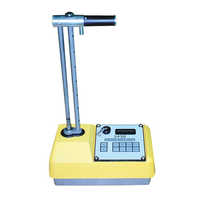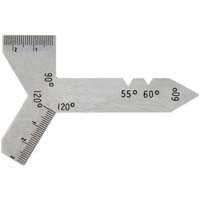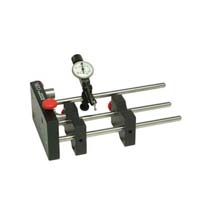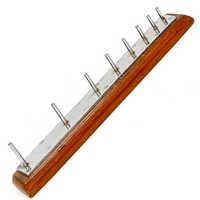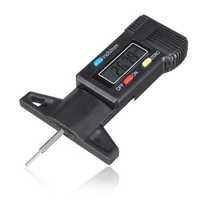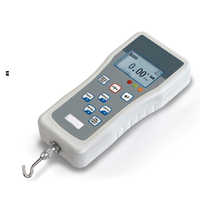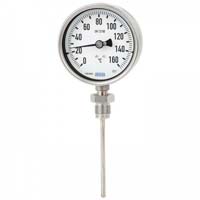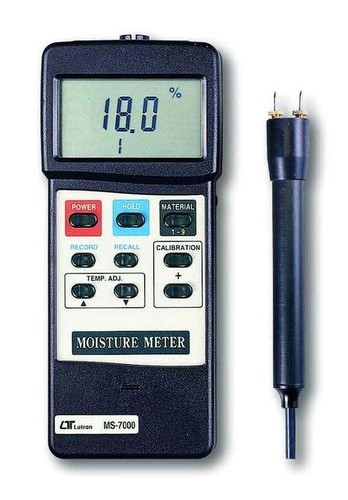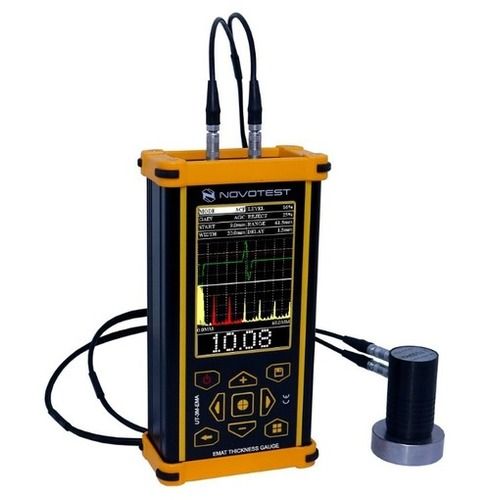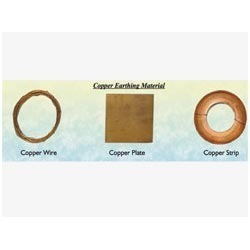Gauges & Gauge Glasses
(3709 products)
Explore More Categories
Product Showcase
Gauge Board Grade: Industrial
Price: 20000 INR (Approx.)/Unit
MOQ - 1 Unit/Units
Usage - Industrial
Display - Analog
Size - Standard
14 Years
Business Type: Manufacturer | Supplier
JSN ENTERPRISE
Ultrasonic thickness gaugue UT-2A A-SCAN
Price: 265879 INR (Approx.)/Piece
MOQ - 1 Piece/Pieces
Product Type - Thickness guague
Color - Yellow
5 Years
Business Type: Manufacturer | Supplier
AERICA ENGINEERING PRIVATE LIMITED
Silver Reflex Level Gauge Indicator
Price Trend: 6000.00 - 36000.00 INR (Approx.)/Piece
MOQ - 1 Piece/Pieces
Product Type - Reflex Level Gauge Indicator
Usage - Industrial
Color - Silver
11 Years
Business Type: Manufacturer | Exporter
KABIR INSTRUMENTS AND TECHNOLOGY
Water Level Gauge
Price Trend: 10800.00 - 33300.00 INR (Approx.)/Piece
MOQ - 10 Piece/Pieces
Usage - In Boiler Plats, Any type of chemical plants to check level of Chemicals , water and any type of liquids
Weight - 20-25 Kilograms (kg)
Size - Customizable
8 Years
Business Type: Manufacturer | Exporter
FLOWTECH MEASURING INSTRUMENTS PVT. LTD.
Regular Oil Level Gauge
Price: 230 INR (Approx.)/Piece
MOQ - 10 Piece/Pieces
Color - Regular
Product Type - Oil Level Gauge
Usage - Oil Tank
12 Years
Business Type: Manufacturer | Distributor
JACKTECH HYDRAULICS
FABRIC THICKNESS GAUGE ..
Price: 1 INR (Approx.)/Piece
MOQ - 1 Piece/Pieces
18 Years
Business Type: Manufacturer | Exporter
ASIAN TEST EQUIPMENTS
Baumer Temperature Transmitter Accuracy: 0.25 %
Price: 2250 INR (Approx.)/Piece
MOQ - 1 Piece/Pieces
Color - Black
Size - 8-12 MM
Material - Metal
14 Years
Business Type: Manufacturer | Distributor
FUTURISTIC TECHNOLOGIES
Indian Inquiries Only
Sj210 Mitutoyo Surface Roughness Tester Grade: Industrial Grade
Price: 115500 INR (Approx.)/Piece
MOQ - 1 Piece/Pieces
Usage - For Industrial And Laboratory Use
Width - 10-50 Millimeter (mm)
Color - White And Brown
17 Years
Business Type: Manufacturer | Supplier
SAMRUDDHI INDUSTRIES
Indian Inquiries Only
Magnetic Level Gauge With Transmitter Application: Chemical Processing
Price: 20000 INR (Approx.)/Unit
MOQ - 1 Unit/Units
Usage - Industrial
Color - Gray
Product Type - Magnetic Level Gauge With Transmitter
11 Years
Response Rate: 79.63%
Business Type: Manufacturer | Exporter
D. B. INSTRUMENTS & CONTROLS
Hypodermic Pressure Guage Accuracy: 160 Psi
Price: nan INR (Approx.)/Piece
MOQ - 1 Piece/Pieces
Usage - Industrial
Size - Standard
Color - Silver & White
16 Years
Business Type: Manufacturer | Distributor
BLASTECH
Indian Inquiries Only
Indian Inquiries Only
Steel Pressure Cum Temperature Gauges
Price Trend: 500.00 - 5000.00 INR (Approx.)/Piece
MOQ - 1 Piece/Pieces
Weight - 400-500 Grams (g)
Color - Silver
Material - Steel
15 Years
Business Type: Manufacturer | Exporter
DYNAMIC ENTERPRISES INC.
Transparent Gauge Glass
Price: 1900 INR (Approx.)/Piece
MOQ - 20 Piece/Pieces
14 Years
Business Type: Manufacturer | Supplier
SHREE UMIYA GLASS WORKS
High Quality Reflex Level Gauge
Price: 13000 INR (Approx.)/Unit
MOQ - 10 Unit/Units
Color - Blue
Usage - Chemical Plant,l Aboratory
Product Type - Reflex Level Gauge
15 Years
Business Type: Manufacturer | Supplier
FIDICON DEVICES INDIA
Magnehelic Differential Pressure Gauge
Price: 6000.00 INR (Approx.)/Piece
MOQ - 1 Piece/Pieces
Product Type - Analouge
Glass Size - 4"
Width - NA
2 Years
Business Type: Manufacturer | Supplier
Nextech Sensors & Controls
Black Reflex Level Gauge
Price: 25000 INR (Approx.)/Piece
MOQ - 1 Piece/Pieces
Usage - Industrial
Product Type - Reflex Level Gauge
Color - Black
13 Years
Business Type: Manufacturer | Supplier
METALEX CRYOGENICS LTD.
Verified Exporter
( Accepts only Foreign Inquiry)
Blue Manifold Pressure Gauge
Price: 2750 INR (Approx.)/Unit
MOQ - 10 Unit/Units
Color - Blue
Product Type - Manifold Pressure Gauge
Size - Different Available
2 Years
Business Type: Distributor | Trading Company
The Refrigeration House
Multicolor Length Gauge For Aggregate
Price: 390 INR (Approx.)/Piece
MOQ - 100 Piece/Pieces
Product Type - Length Gauge
Color - Multicolor
Size - All sizes are available
6 Years
Business Type: Trading Company
YESHA LAB EQUIPMENTS
Indian Inquiries Only
Gray Digital Tyre Pressure Gauge With 7 Emergency Tools
Price: 507.00 INR (Approx.)/Piece
MOQ - 100 Piece/Pieces
Color - Black
Size - 16.1 x 5 x 3.1 cm
Weight - 124.3 Grams (g)
7 Years
Business Type: Manufacturer | Supplier
JAINEX CORPORATE GIFTS
Gauges & Gauge Glasses Manufacturers | Suppliers in India
| Company Name | Location | Member Since |
|---|---|---|
| Asian Test Equipments | Hapur, India | 18 Years |
| Samruddhi Industries | Ahmedabad, India | 17 Years |
| Blastech | Mumbai, India | 16 Years |
| Modern Traders | Mumbai, India | 15 Years |
| Dynamic Enterprises Inc. | Pune, India | 15 Years |
| Electronic & Engineering Co. (I) P. Ltd. | Mumbai, India | 15 Years |
| Fidicon Devices India | Ankleshwar, India | 15 Years |
| Spectec Techno Projects Pvt. Ltd. | New Delhi, India | 15 Years |
| Jsn Enterprise | Vadodara, India | 14 Years |
| Futuristic Technologies | Ahmedabad, India | 14 Years |
Gauges & Gauge Glasses: Types & Applications
Introduction
A gauge glass is a transparent tube used to monitor liquid levels in a tank or boiler. A sight glass, also known as a gauge glass, is used to determine the depth of a liquid. When installed in a tank or vessel, it provides a constant readout of the liquid's level.
One way to check the water level in a tank is with a sight glass instrument, which consists of a graduated tube made of toughened glass that is attached to the tank's interior at its base. The sight glass in the picture below is a straightforward method of gauging the contents of an open tank, as the liquid level in the sight glass precisely parallels the tank's actual contents.
Changes in the liquid level in the tank are reflected in the sight glass in a similar fashion. The sight glass can be used to determine how much liquid is in the storage tank.
Different types of gauges & gauge glasses
1. Multifunctional Glass
These tools incorporate not just the aforementioned capabilities, but also others, such as the ability to remove the sight glass for cleaning and examination.
2. 3D
This sight glass is similar to a bullseye, except instead of being flat, it protrudes from a tank. It also lets light travel through the oil, making it simpler to spot pollutants, and increases the number of perspectives from which you can examine the oil.
Most of these can withstand high pressure and high temperatures since they are constructed of glass, acrylic, or polyamide.
3. BS&W Bowls
Bowls designed to collect sediment and water from the tank's base are called bottom sediment and water (BS&W) bowls. There is a release valve on several of them so that oil samples can be taken for testing.
These are significantly more compact than their columnar counterparts and can be installed towards the bottom of tanks, where they are more vulnerable to damage.
4. Columnar
These transparent, vertical tubes are installed on the exterior of storage tanks and provide a more comprehensive view of the oil inside than traditional bullseye sight glasses.
However, they are more challenging to install, and since they are usually placed near the tanks' bases, they are more likely to sustain damage.
Also, they have trouble detecting foaming because they draw from the tank's base. When compared to bullseye, the use of columnar Gauges & Gauge Glasses allows for the accurate marking of oil levels in both the running and idled states of a machine.
Target glasses can only differentiate between the two.
5. Bullseye
When installing a bullseye Gauges & Gauge Glasses, a hole is drilled into the tank at the ideal oil level. When installed, the sight glass resembles a bolt with a glass head and is threaded into the opening.
Several models feature a line in the sight glass at the proper oil level for operating machinery.
A bullseye Gauge Glasses can aid in the detection of foaming in the system. In the presence of water and other impurities, this frequently occurs, allowing you to spot issues before they become catastrophic.
6. Circular Sight Glass Fittings
Sight glasses, also known as sight windows or view ports, allow for inspection of the contents of a tank or vessel from the outside.
They are made up of two flanges that are bolted together and seal a glass disc with gaskets. Commonly used to check liquid levels and visually validate process steps.
Pressure vessels, tanks, silos, stirred vessels, separators, pipelines, etc., can all benefit from inspections using this method.
7. Sight Indicators
This is a device that is placed in a pipeline to check the flow of a liquid, powder, or gas. A body with a window or windows is what makes up this thing. This method is the most accurate for validating flow's direction, approximate rate, color, and clarity.
For clean rooms, hospitals, and other sterile environments, Sight Glass producers provide both regular and full-view flow indicators.
8. Metaglass Sight Glass Windows
The "METAGLAS®" brand of metal fused sight glasses has a sight glass fused into a steel ring. This is because glass and metal have differing expansion coefficients, leading to compressive stress within the glass. The steel ring's mechanized treatment allows for a wide range of potential building solutions.
9. Rectangular Sight Glass Fittings
Gauge Glasses, which are also known as sight windows or view ports, allow one to see inside a tank or vessel by way of two flanges that are bolted together and seal a glass disc with gaskets.
Most commonly employed for visual inspection of process material and liquid levels as well as verification of process phases. Tanks, stirred vessels, pressure vessels, separators, pipelines, silos, and so on are common places where this technology is put to use.
Applications of gauges & gauge glasses
1. Tanks and Reservoirs
Gauges & Gauge Glass, also known as sight glass, is an indispensable component of tanks and reservoirs because it allows for quick and easy monitoring of liquid levels. The Red Line variation, designed to be installed between the upper and lower Gauges & Gauge Glass valves, contains a red line that is tinted with white lines to facilitate readings.
2. High and Low pressure boiling
Gauge Glasses are perfect for liquid measurement in boilers due to their exceptional thermal endurance, great clarity, and consistent operation even at high temperatures.
3. Flow meters
Gauge Glasses provide precision, safety, and reliability for sectors that need to measure the volume of gas or liquid passing through a device. Industrial flow meters require gauge glasses because of their excellent resilience to chemical and thermal shock.
Things To Consider Before Purchasing Gauges & Gauge Glasses
1. Impact
Materials entrained in process fluids may strike the sight glass window in some operations, such as food processing. If you notice any scratches on your glasses, it's time to get a new pair.
2. Pressure
All high-pressure applications should employ fused-type sight glasses or cast-type plastic windows to prevent sight glass failure, as was previously mentioned.
3. Abrasion
Pick a material for the sight glass that won't wear down or become clouded by particles in the fluid being viewed. Sight glasses can be tested for scratches either visually or with the help of ultrasonic technology.
4. Corrosion
Sight glass windows can grow "cloudy" over time when exposed to certain caustic or acidic chemicals, reducing their transparency. Select a plastic or glass sight glass window that is less likely to corrode in these sorts of applications.
5. Thermal Shock
When deciding on a material for a sight glass, engineers must keep in mind how the material will react to extreme temperature swings. Since it has a lower coefficient of expansion than regular glass, borosilicate glass can better withstand temperature swings and is hence the material of choice for glass windows. Sight glass windows made of plastic can withstand variations in temperature because of their flexibility.
6. Maximum Operating Temperature
Regular soda lime sight glass windows and plastic view ports can only be used in environments with temperatures no higher than 300 degrees Fahrenheit. Glasses made of borosilicate or quartz/sapphire must be used above those temperatures.
7. Construction materials
The two most popular metals are carbon steel and stainless steel. For this reason, stainless steel is the industry standard in the pharmaceutical industry due to its superior corrosion resistance.
8. Process fluid
Before filling a reservoir or tank with fluid, find out what kinds of things it can corrode. If you need a sight glass, one with "excellent" chemical resistance is what you should be on the lookout for.
9. Past Issues
Check to see if there have been any past issues that you need to keep an eye on. Have you ever experienced lubricant contamination due to wear debris? If so, select a sight glass outfitted with a magnetic plug to aid in capturing the debris before proceeding with testing.
Conclusion
Depending on the gasket and clamp union you choose, the maximum temperature and pressure are also different. Sight glasses are vital tools in the process industries, where they are used to inspect tanks and pipelines for fluid and media levels
Sight glasses are a type of specialized instrument that have many applications in the processing industries. This post has provided an overview of sight glasses and how they are used in the pharmaceutical, food and beverage, semiconductor, utility, energy, oil and gas, and wastewater management industries.
FAQs: Gauges & Gauge Glasses
Q. Which type of gauge & gauge glass is commonly used in the laboratory?
Ans. Tubular Gauge Glasses are mostly used in Laboratories for liquid level uses in industrial steam boilers.
Q. How do Gauges & Gauge Glasses work?
Ans. Gauge glasses, once fitted, function as windows to allow operators to monitor internal activities in a variety of containers, such as tanks, vessels, reactors, and pipes. Gauge glasses are made from either soda lime glass or borosilicate glass because of their durability.
Q. What happens if the Gauge & gauge glass break?
Ans. That way, even if the gauge & gauge glass breaks, the stop ball will keep the water from escaping.
Q. What is the cost of Gauges & Gauges glass?
Ans. The cost of Gauge Glasses is between Rs 900- Rs 2,500 in India.
Related Categories
Abrasives
Acoustic Products
Acrylic Sheets
Air Blowers
Air Compressors & Air Separation Plants
Air Cooler
Air Dryers
Air Receiver
Air Valves
Aluminum Castings
Anchors
Anti Vibration Mounts
Ball & Roller Bearings
Ball Valves
Ballast Making Machines
Bearing Parts & Components
Bearings
Bellows & Expansion Joints
Belt Pulleys
Boilers, Components & Spares
Bolts
Bright Bars
Bristles
Burners/Industrial Burners & Incinerators
Bushings & Bushing Parts
Butterfly Valves
CNC Machined Components
Cable Pulleys
Capital Goods
Carbon & Graphite Products
Castor Wheels
Centrifugal Pumps
Centrifuges
Ceramics
Chains & Chain Link Fence Fittings
Cleaning Equipment
Clips, Clamps
Coils
Combustion Equipment
Compression Springs
Compressors & Allied Equipment
Control Valves
Conveyor & Conveyor/Industrial Belts
Cooling Tower & Chilling Plants
Corrosion Protection Materials
Coupling
Cranes
Cryogenic Equipment
Cutting Tools, Broaches & Cutters
Departmental Shelving
Diaphragm Valves
Die Castings
Dies & Moulds
Dies,Jigs,Fixtures
Diesel Engine & Electric Locomotive Spares
Draught Fan
EOT Cranes
Electric Hoists
Electric Motors & Engines
Electroplating Chemicals & Equipment
Elevators, Lifts & Escalators
Energy Management System
Engine Valves
Engineering Goods & Equipment
Engineering Plastics
Engraving Equipment
Extruded Profiles
Fasteners
Fiberglass Products
Filter Cartridges & Media
Filter Cloth, Filter Industrial
Filters-Air, Gas, Liquid
Filtration & Sedimentation Units
Flat Metal Processing Equipment
Float Valves
Fork Lift Truck Parts
Fork Lift Trucks
Forklifts
Foundry Raw Material & Equipment
Furnace Manufacturers
Galvanized Fasteners
Gantry Cranes
Gaskets
Gate Valves
Gauges & Gauge Glasses
Gear Boxes, Reduction Gears & Gear Cutting
Girder Cranes
Glass & Glass Products
Glass Cutting Tools/Glass Cutters
Globe Valves
Goliath Cranes
Grating
Hand & Allied Tools
Hand Pump
Hardware & Tools
Heat Exchangers
Heating Elements
Hex Bolts
Hex Nuts
Hooks & Mounts
Hoses
Hot Air Oven
Humidification & Ventilation Equipment
Hydraulic Hoses & Flexible Metal
Hydraulic Press
Hydraulic Press Brakes
Hydraulic Products & Equipment
Hydraulic Valves
Induction Heating Equipment
Industrial Automation
Industrial Brakes
Industrial Brushes
Industrial Clothing
Industrial Clutches
Industrial Cylinders
Industrial Dryers
Industrial Evaporators
Industrial Knives
Industrial Nets
Industrial Ovens
Industrial Rollers
Industrial Supplies Stocks
Industrial Supplies-General
Industrial Tape
Industrial Tools
Industrial Valves
Industrial Vibrator
Inspection Equipment
Instrumentation
Internal Combustion Engine
Jib Cranes
Laboratory Furniture
Laboratory Glassware & Equipment
Laundry Equipment
Lined Valves
Machine Tools Accessories
Marking Systems
Material Handling Equipment
Measuring Tools & Equipment
Mechanical Seals
Metallised Capacitor Films
Mining Equipment
Mining, Exploration & Drilling Machinery
Model Making Materials
Motor Couplings
Moulded Components
Moulds
Needle Valves
Needles
Nuts
Oil Seals
Outdoor Cooling Systems
Overhead Cranes
PVC Hoses
PVC Products
Paint Brushes
Painting Equipments & Maintenance
Perforated Sheets
Plastic Processing Machinery Parts
Plastic Valves
Plastic Welding Equipment
Plate Valves
Plug Valves
Pneumatic Products & Tools
Pneumatic Valves
Polish & Polishing Material/Machinery
Power Press
Precision Brass Components
Pressed Components
Pressure Gauges
Pressure Vessels
Pulleys
Pulverizers
Pump Spares Parts
Pumps & Pumping Equipment
Radiators
Refrigeration & Equipment
Rope Pulleys
Rope,Twines & Webbings
Ropes
Rotary Valves
Rubber & Rubber Products
Rubber Gaskets
Rubber Roller
Rubber Seals
Rubber Transmission Belts
Screws
Seals
Sensors & Transducers
Shaft Couplings
Shafts & Shaft Collars
Sheet Metal Components & Parts
Solenoid Valves
Springs
Stainless Steel Bolts
Stainless Steel Fasteners
Stainless Steel Nuts
Stainless Steel Valves
Storage Systems
Storage Tanks
Submersible Pumps
Surface Finishing Equipment
Synthetic Industrial Diamonds
Testing & Measuring Equipment
Thermostatic Bimetals & Thermostats
Trolleys & Carts
Tungsten Carbide
Ultrasonic Equipment
V-Belts
Vacuum Equipment & System
Valves
Valves Fittings
Vibrating Screen
Washers
Water Coolers
Weighbridge
Welding & Soldering Supplies
Welding Electrodes
Welding Equipment
Winches
Wire Drawing Dies
Wire Rope Hoists
Wire Ropes
